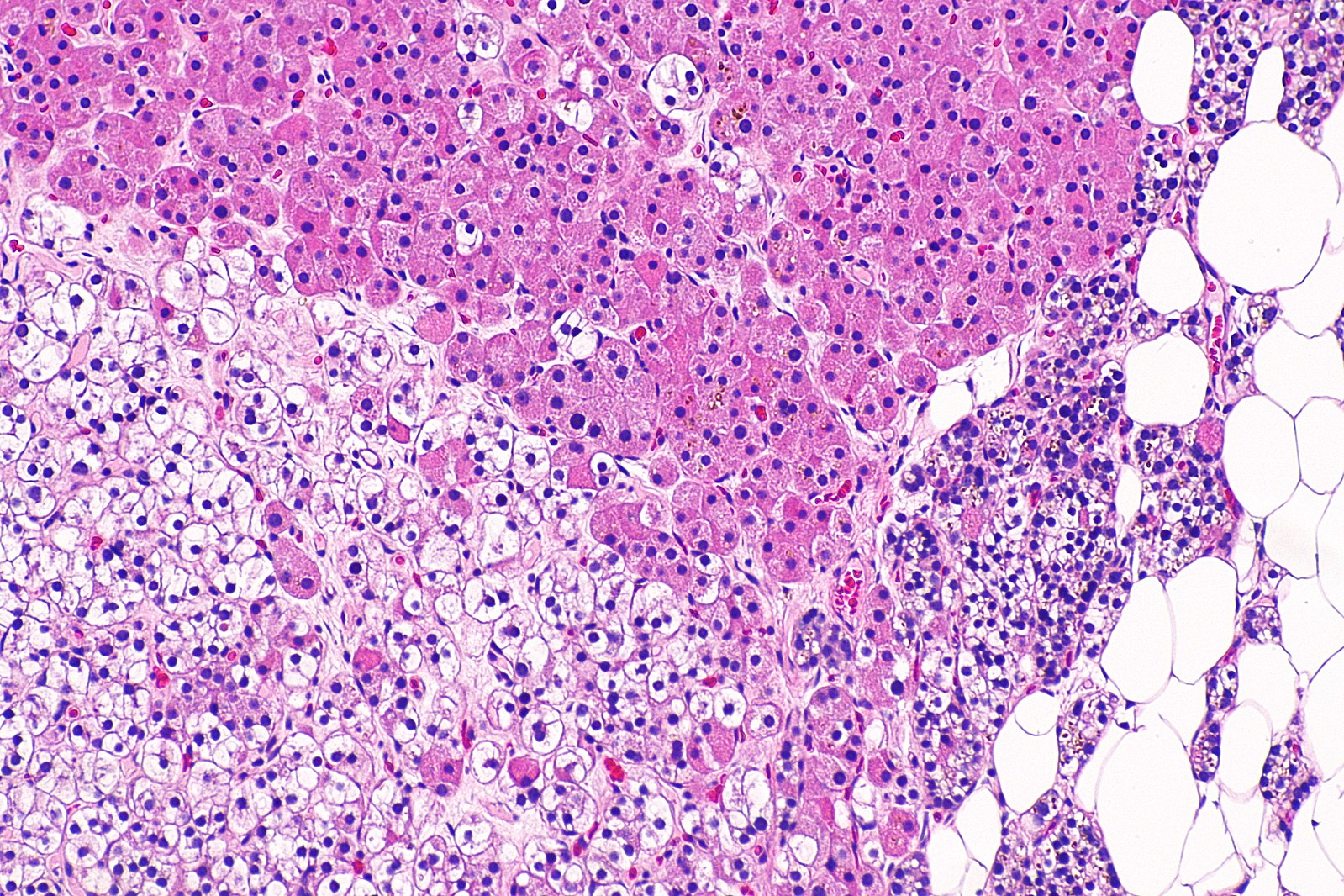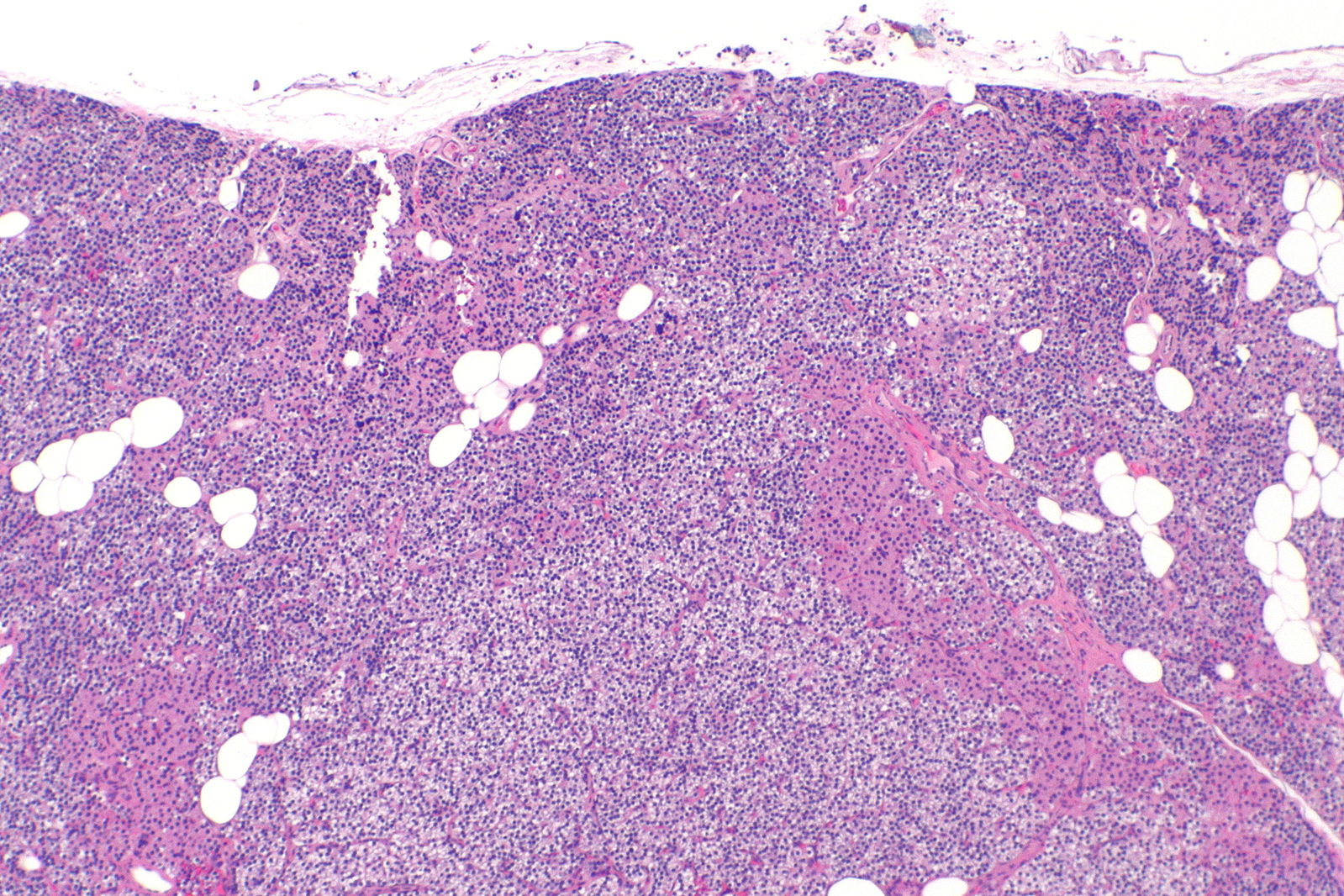Difference Between Parathyroid Adenoma and Parathyroid Hyperplasia
Both parathyroid adenoma and parathyroid hyperplasia can cause hyperparathyroidism, a disease characterized by excessive parathyroid hormone secretion. They also have the same symptoms such as constipation, lethargy, and weak bones. As for their difference, parathyroid adenoma only involves one gland while parathyroid hyperplasia affects all of the four glands. The following discussions further delve into their distinctions.

What is Parathyroid Adenoma?
Parathyroid adenoma is a benign tumor (not usually problematic and do not spread to other body parts) on one of the parathyroid glands (four small glands situated at the back of the thyroid gland) which helps control the calcium and phosphorus levels in the blood. It leads to an increase in the release of parathyroid hormone (PTH) which disrupts the body’s calcium and phosphorus balance (Holm, 2017).
Many individuals with parathyroid adenoma do not experience symptoms; in fact, it is usually discovered when blood tests are done for another medical reason. Parathyroid adenomas are the most common cause of hyperparathyroidism which is characterized by lack of energy, confusion, constipation, muscle pain, decreased appetite, lethargy, nausea, weak bones, fractures, and urinating more often at night.
Most parathyroid adenomas do not have known causes. For some patients, the causes include genetic disorders, taking lithium drugs, and chronic kidney disease. There is a higher risk for women over age 60 and those who are exposed to radiation to the head and neck. Regarding treatment, the most common cure is surgery. Patients with mild conditions often choose to have regular checkups. They may also be asked to stop taking calcium and vitamin D supplements (Wisse & Zieve, 2020).

What is Parathyroid Hyperplasia ?
Parathyroid hyperplasia is a condition characterized by the enlargement of the parathyroid glands; all of the parathyroid cells in all four glands are abnormal. This may be inherited as part of three syndromes: multiple endocrine neoplasia type I, multiple endocrine neoplasia type II, and isolated familial hyperparathyroidism. This may occur in individuals without a family history, and it is more commonly caused by other medical conditions such as chronic kidney disease and chronic vitamin D deficiency (National Institutes of Health, 2021).
The symptoms of parathyroid hyperplasia are the same with those of parathyroid adenoma. The preferred treatment is surgery; 3.5 glands are usually removed, and the remaining tissue may be implanted on the forearm so the doctor can easily operate on it just in case the symptoms will recur. Moreover, the tissue may help in controlling calcium levels (Mount Sinai, 2021). The parathyroidectomy for parathyroid hyperplasia involves a decision regarding which glands will be removed. Hence, the surgeon’s expertise in identifying the abnormal glands is highly crucial (Center for Advanced Parathyroid Surgery).
Difference between Parathyroid Adenoma and Parathyroid Hyperplasia
Definition
Parathyroid adenoma is a benign tumor on one of the parathyroid glands (Holm, 2017). There are rare instances when parathyroid adenomas appear in more than one gland at the same time (Center for Advanced Parathyroid Surgery). In comparison, parathyroid hyperplasia is a condition characterized by the enlargement of the parathyroid glands; all of the parathyroid cells in all four glands are abnormal (National Institutes of Health, 2021).
Cause
Most parathyroid adenomas do not have known causes. For some patients, the causes include genetic disorders, taking lithium drugs, and chronic kidney disease. There is a higher risk for women over age 60 and those who are exposed to radiation to the head and neck (Wisse & Zieve, 2020). As for parathyroid hyperplasia, this may be inherited as part of three syndromes: multiple endocrine neoplasia type I, multiple endocrine neoplasia type II, and isolated familial hyperparathyroidism. This may occur in individuals without a family history, and it is more commonly caused by other medical conditions such as chronic kidney disease and chronic vitamin D deficiency (National Institutes of Health, 2021).
Surgery
As compared to parathyroid adenoma, the parathyroidectomy for parathyroid hyperplasia is generally more complicated since there are more glands involved. A decision regarding which glands will be removed among the 4 needs to be made and the surgeon’s expertise in identifying the abnormal glands is highly crucial. On the other hand, the surgery for parathyroid adenoma is minimally invasive as it aims to remove only the abnormal gland and leave the healthy glands undisturbed (Center for Advanced Parathyroid Surgery).
Parathyroid Adenoma vs Parathyroid Hyperplasia

Frequently Asked Questions:
Is parathyroid hyperplasia curable?
Yes. The preferred treatment is surgery; 3.5 glands are usually removed, and the remaining tissue may be implanted on the forearm so the doctor can easily operate on it just in case the symptoms will recur. Moreover, the tissue may help in controlling calcium levels (Mount Sinai, 2021).
Does parathyroid disease cause weight gain?
Yes. Parathyroid disease is associated with weight gain which is a common concern for patients with hormone problems such as hyperparathyroidism (Norman, 2017).
What happens if hyperparathyroidism is left untreated?
If left untreated, hyperparathyroidism can lead to kidney stones, osteoporosis, mood changes, fatigue, muscle pain, bone aches, or even cardiac dysrhythmias (MedStar Washington Hospital Center, 2016).
Summary
- Parathyroid adenoma is a benign tumor on one of the parathyroid glands while parathyroid hyperplasia is a condition characterized by the enlargement of the parathyroid glands.
- The symptoms of parathyroid hyperplasia are the same with those of parathyroid adenoma.
- As compared to parathyroid adenoma, the parathyroidectomy for parathyroid hyperplasia is generally more complicated since there are more glands involved.
- Difference Between Hematoma and Melanoma - February 9, 2023
- Difference Between Bruising and Necrosis - February 8, 2023
- Difference Between Brain Hematoma and Brain Hemorrhage - February 8, 2023
Search DifferenceBetween.net :
Leave a Response
References :
[0]Center for Advanced Parathyroid Surgery. Parathyroid Adenoma or Parathyroid Hyperplasia. https://www.hyperparathyroidmd.com/parathyroid-adenoma-or-hyperplasia/
[1]Holm, G. (2017). Parathyroid adenoma. Healthline. https://www.healthline.com/health/parathyroid-adenoma
[2]MedStar Washington Hospital Center (2016). Avoid a hyperparathyroidism misdiagnosis. Science Daily. https://www.sciencedaily.com/releases/2016/10/161024140516.htm
[3]Mount Sinai (2021). Center for thyroid and Parathyroid disease. https://medlineplus.gov/ency/article/001189.htm
[4]National Institutes of Health (2021). Parathyroid hyperplasia. MedlinePlus. https://medlineplus.gov/ency/article/001189.htm
[5]Norman, J. (2017). Parathyroid disease and weight gain with hyperparathyroidism. Parathyroid.com. https://www.parathyroid.com/blog/parathyroid-surgery-weight-gain
[6]Wisse, B. & Zieve, D. (2020). Parathyroid adenoma. Penn Medicine. https://www.pennmedicine.org/for-patients-and-visitors/patient-information/conditions-treated-a-to-z/parathyroid-adenoma
[7]Image credit: https://commons.wikimedia.org/wiki/File:Parathyroid_hyperplasia_--_low_mag.jpg
[8]Image credit: https://commons.wikimedia.org/wiki/File:Parathyroid_adenoma,_mixed_type_--_intermed_mag.jpg
